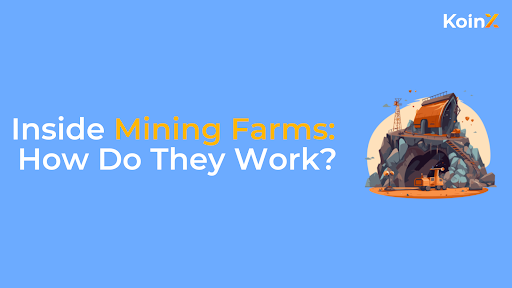Have you ever wondered what goes on behind the scenes of the digital gold rush? Mining farms, the powerhouses of the cryptocurrency world, are the unsung heroes that keep the blockchain networks running.
These specialised facilities, often housed in remote locations with cheap electricity, are packed with thousands of high-powered computers working tirelessly to solve complex mathematical problems. By successfully decrypting the puzzles, miners validate transactions on the blockchain and earn rewards in the form of cryptocurrency.
In this post, we’ll delve deep into the inner workings of mining farms, exploring the hardware, software, and energy consumption involved. We’ll uncover the challenges and rewards associated with this high-stakes industry and discuss the future of mining as technology evolves.
What Are Mining Farms?
Mining farms, or cryptocurrency mining farms, are large facilities that power the mining process for cryptocurrencies like Bitcoin and Ethereum. These farms house rows of specialised computer hardware designed to solve complex cryptographic puzzles. By solving these, mining farms validate and record transactions on a blockchain, which helps secure the network and keep it functional.
To mine effectively, mining farms use powerful hardware like ASICs (Application-Specific Integrated Circuits) and high-performance graphics cards. These specialised machines require vast amounts of electricity to operate continuously. For this reason, mining farms are often set up in areas with affordable electricity. Cooling systems are also essential, as the equipment generates a significant amount of heat.
Mining farms play a crucial role in the cryptocurrency ecosystem. They ensure blockchain security and reward miners with new cryptocurrency tokens and transaction fees, though they have faced criticism for their environmental impact.
How Do Mining Farms Function?
Mining farms, or crypto farms, are massive facilities dedicated to mining cryptocurrencies like Bitcoin and Ethereum. They form the backbone of blockchain networks, providing essential computing power to validate transactions and generate new blocks.
Hardware Setup in Mining Farms
Mining farms use specialised hardware known as mining rigs or ASIC (Application-Specific Integrated Circuit) miners. These rigs are purpose-built to perform the intense calculations needed for mining.
Each rig typically consists of multiple powerful GPUs (Graphics Processing Units) for mining coins that support GPU mining, while coins like Bitcoin, which rely on specific algorithms, require ASIC miners.
For example, Bitcoin uses the SHA-256 algorithm, and Ethereum employs Ethash. This specialised hardware enables mining farms to process transactions swiftly and effectively, as the intense competition demands maximum computing efficiency.
Mining Software Configuration
Mining rigs also require dedicated mining software to connect to the blockchain network. This software allows miners to specify which cryptocurrency they want to mine and, in many cases, join a mining pool. The mining software manages the connection to the network, facilitating the entire mining process by ensuring the rigs are continually working towards solving cryptographic puzzles.
Active Blockchain Network Participation
Each miner within a crypto farm connects to the blockchain network, where they receive unconfirmed transactions from the network’s “mempool.” Miners then group these transactions into a block, preparing it for validation.
Through continuous calculations, miners attempt to solve complex cryptographic puzzles, or proof-of-work (PoW) algorithms, unique to each transaction block. This solution process is crucial, as it ensures the block’s legitimacy.
Proof-of-Work Solution and Block Verification
Miners within the farm race to solve these cryptographic puzzles, with the first to succeed broadcasting the solution to the network. Other nodes on the blockchain verify this solution to ensure accuracy. If correct, the network accepts the new block, and the successful miner receives a block reward—usually in newly created coins—and transaction fees.
Resource and Energy Demands
Mining farms operate around the clock to maximise their chances of winning rewards. However, this continuous operation requires substantial power and cooling resources, as the mining process is energy-intensive. The enormous electricity demands not only power the rigs but also cool them, preventing overheating and hardware damage.
Mining Pools for Better Consistency
Given the competitive nature of mining, many miners join mining pools, combining their resources to improve their reward consistency. In a mining pool, miners share computational power, allowing them to achieve more regular payouts based on each participant’s contribution, which can be more reliable than solo mining.
What Is The Need For Crypto Mining Farms?
Crypto mining farms play a crucial role in the cryptocurrency ecosystem, supporting the network in several key ways. Let’s explore why mining farms have become so essential for miners and the overall crypto landscape.
Transaction Validation
Mining farms handle the vital task of validating transactions on the blockchain. Each time someone sends cryptocurrency, the network needs a secure way to confirm and record the transaction. Mining farms solve this by using powerful hardware to verify transactions accurately. This process ensures that transactions are legitimate and prevents issues like double-spending, where the same cryptocurrency could otherwise be used twice. Without mining farms, the blockchain would lose its reliability, impacting the entire crypto network.
New Coin Generation
Another critical function of crypto mining farms is the generation of new coins. Cryptocurrencies like Bitcoin rely on a process called “proof of work,” where miners solve complex mathematical puzzles to unlock new coins. Mining farms, equipped with specialised hardware, perform these computations at high speeds, ensuring a steady supply of new cryptocurrency into the market. This continuous generation of coins maintains the flow of currency within the network, making it possible for new users to join the ecosystem.
Network Security
The decentralised nature of cryptocurrency relies heavily on the contributions of mining farms. By engaging in the mining process, these farms help secure the network from potential attacks. Mining farms create a competitive environment where many different nodes participate in transaction validation, making it extremely difficult for any single entity to manipulate the blockchain. This structure strengthens the network’s security and ensures that no single group can control it, preserving the core principle of decentralisation in cryptocurrency.
Economic Incentives
Crypto mining farms also offer financial incentives for miners, which makes mining a lucrative venture. Each time a miner validates a transaction block, they receive rewards in the form of newly minted coins or transaction fees. These rewards can be significant, especially when mining at scale with the efficiency of a dedicated mining farm. Economic incentives encourage more miners to participate, which in turn strengthens the network and supports the continuous growth of the crypto ecosystem.
Conclusion
Mining farms are the backbone of the cryptocurrency ecosystem, ensuring the security and decentralization of blockchain networks. While they offer lucrative rewards, they also present significant challenges, including high energy consumption and intense competition.
As technology advances and new mining techniques emerge, the future of mining farms remains uncertain. However, one thing is clear: these facilities will continue to play a crucial role in shaping the future of cryptocurrency and blockchain technology




